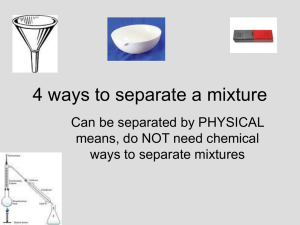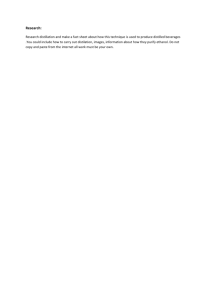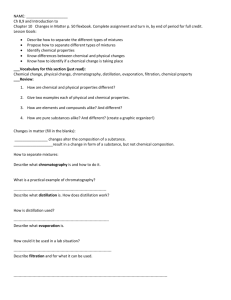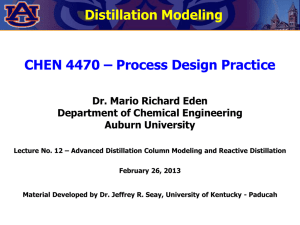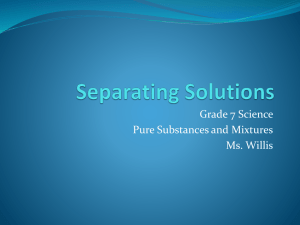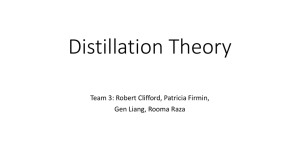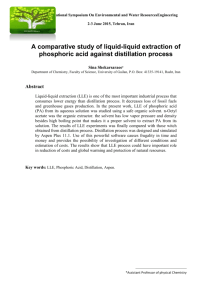Simulation Of Reactive Distillation Column
advertisement
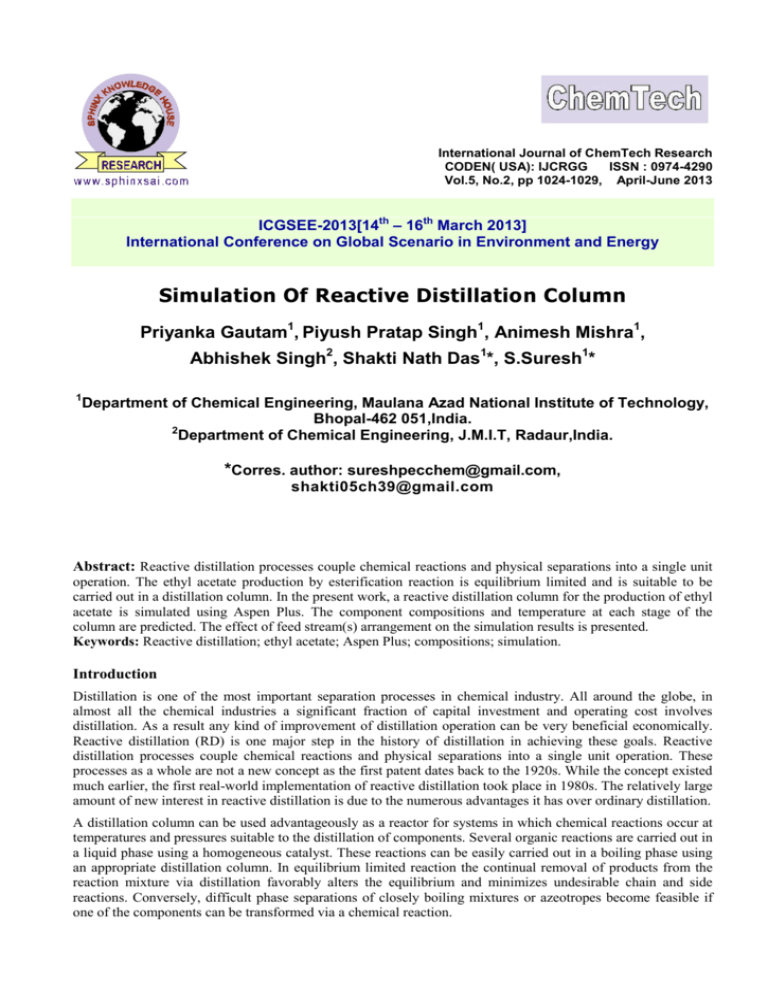
International Journal of ChemTech Research CODEN( USA): IJCRGG ISSN : 0974-4290 Vol.5, No.2, pp 1024-1029, April-June 2013 ICGSEE-2013[14th – 16th March 2013] International Conference on Global Scenario in Environment and Energy Simulation Of Reactive Distillation Column Priyanka Gautam1, Piyush Pratap Singh1, Animesh Mishra1, Abhishek Singh2, Shakti Nath Das1*, S.Suresh1* 1 Department of Chemical Engineering, Maulana Azad National Institute of Technology, Bhopal-462 051,India. 2 Department of Chemical Engineering, J.M.I.T, Radaur,India. *Corres. author: sureshpecchem@gmail.com, shakti05ch39@gmail.com Abstract: Reactive distillation processes couple chemical reactions and physical separations into a single unit operation. The ethyl acetate production by esterification reaction is equilibrium limited and is suitable to be carried out in a distillation column. In the present work, a reactive distillation column for the production of ethyl acetate is simulated using Aspen Plus. The component compositions and temperature at each stage of the column are predicted. The effect of feed stream(s) arrangement on the simulation results is presented. Keywords: Reactive distillation; ethyl acetate; Aspen Plus; compositions; simulation. Introduction Distillation is one of the most important separation processes in chemical industry. All around the globe, in almost all the chemical industries a significant fraction of capital investment and operating cost involves distillation. As a result any kind of improvement of distillation operation can be very beneficial economically. Reactive distillation (RD) is one major step in the history of distillation in achieving these goals. Reactive distillation processes couple chemical reactions and physical separations into a single unit operation. These processes as a whole are not a new concept as the first patent dates back to the 1920s. While the concept existed much earlier, the first real-world implementation of reactive distillation took place in 1980s. The relatively large amount of new interest in reactive distillation is due to the numerous advantages it has over ordinary distillation. A distillation column can be used advantageously as a reactor for systems in which chemical reactions occur at temperatures and pressures suitable to the distillation of components. Several organic reactions are carried out in a liquid phase using a homogeneous catalyst. These reactions can be easily carried out in a boiling phase using an appropriate distillation column. In equilibrium limited reaction the continual removal of products from the reaction mixture via distillation favorably alters the equilibrium and minimizes undesirable chain and side reactions. Conversely, difficult phase separations of closely boiling mixtures or azeotropes become feasible if one of the components can be transformed via a chemical reaction. Shakti Nath Das et al/Int.J.ChemTech Res.2013,5(2) 1025 The Computational methods used for reactive distillation are extensions to the algorithms developed for the solution of the equations for conventional distillation. The first attempts to model reactive distillation were by using the simplified plate-to-plate calculations. Rigorous mathematical models for Computer simulation was not developed until the 1970's. Since that time, various techniques have been developed that allow the rigorous solution of the equations. These techniques include equation partitioning methods, and Newton-Raphson based methods. A brief description of computer based tray-to-tray calculations for the RD of ethylene oxide and water was given in1. Tray-to-tray calculations and parametric studies for the simulation and optimization of an RD column for trioxane synthesis are described in2. The bubble-point method3 was extended in4 to be able to deal with chemical reactions. The θ method developed for conventional distillation columns by Holland and his many collaborators5 was extended to RD operations and named the multi-θ-η method6. More recent papers in this field7,8 use the simultaneous solution of all the independent equations using Newton's method or a variant of this method. Reactive distillation column for the production of ethyl acetate using simultaneous solution after linearization and inside-outside method, a tearing algorithm is compared in9 using a 13 tray ethyl acetate producing column. The convergence is shown to be faster with inside-outside algorithm. The inside-out algorithm is described in10 known as RADFRAC that is part of the commercial program Aspen Plus. Inside-out methods involve the introduction of new parameters into the model equations to be used as primary iteration variables. In this work ethyl acetate production through reactive distillation is simulated using Aspen Plus. MODEL Description In this paper, an equilibrium model is used for the simulation of reactive distillation of ethyl acetate production (C2H5COOCH3), using acetic acid (CH3COOH) and ethanol (C2H5OH), in a plate column. The reaction is carried out using a homogeneous catalyst. The reaction kinetics data is taken from9. A thirteen stage column example is taken from C.D. Holland’s book5. A constant-pressure adiabatic column, a total condenser, and a partial reboiler are assumed. The liquid feed enters the column on stage 6. Stages are numbered from top condenser being stage 1 and reboiler stage 13. RADFRAC representation of the column is shown in Fig. 1. Figure 1. Radfrac representation of RD column The specifications of the RD column and the other parameters used for simulation study are given in Table 1. Shakti Nath Das et al/Int.J.ChemTech Res.2013,5(2) 1026 Table 1. Column specifications and other parameters used for simulations Feed Temperature Pressure Total Stages Feed Stage Distillate Rate Holdup Component mol fractions Acetic Acid Ethanol Water Ethyl acetate Property method Reaction 340 K 1 atm 13(including Reboiler & condenser) 6 0. 208 mol/s 1 l for reboiler, 0.3 l for each stages 0.4962 0.4808 0.023 0.0 UNIFAC-HOC CH3COOH+C2H5OH C2H5COOCH3+H2O Results And Discussion Stage number 11.0 6.0 1.0 The simulations are carried out using Aspen Plus. Reflux ratio of 10 was selected as optimum as beyond this value the increased reflux had little effect on ethyl acetate purity in the distillate. All further simulations were done using a reflux ratio equal to 10. Figs. 3, 4, and 5 show the results of component concentration profiles, temperature and ethyl acetate generation rate at each stage. The results compare well with the results reported in1. 0.0 Acetic acid Ethyl acetate Ethanol Water 0.1 0.2 0.3 0.4 0.5 Component mole fraction 1.0 Figure 3. Predicted component composition profiles Block RADFRAC: Temperature Profile Stage number 11.0 6.0 Temperature C 70.0 71.0 72.0 73.0 74.0 75.0 76.0 77.0 78.0 79.0 80.0 81.0 82.0 Temperature (deg C) Figure 4. Predicted Temperature Profile Ethyl acetate mole-flow 0.0 2.e-004 4.e-004 Shakti Nath Das et al/Int.J.ChemTech Res.2013,5(2) 1.0 2.0 Component generation ethyl acetate 3.0 4.0 5.0 6.0 7.0 8.0 9.0 10.0 11.0 12.0 13.0 Stage number Figure 5. Ethyl acetate generation rate T-xy variation: 1027 Shakti Nath Das et al/Int.J.ChemTech Res.2013,5(2) 1028 Y-x variation: P-xy variations: Conclusion The reactive distillation column for the production of ethyl acetate is simulated using RADFRAC model of Aspen Plus. The results compare well with the reported literature. However, the purity achieved in the product for stoichiometric feed of reactants is not high. Shakti Nath Das et al/Int.J.ChemTech Res.2013,5(2) 1029 References 1. Corrigan, T.E., and Miller, J.H., Effect of Distillation on a Chemical Reaction, Ind. Eng. Chem. Res. Proc. Des. Dev., 7, 383-384, 1968. 2. Hu, M., Zhou, X.G., and Yuan, W.K., Simulation and Optimization of a Coupled Reactor/column System for Trioxane Synthesis, Chem. Eng. Sci., 54, 1353-1358, 1999. 3. Wang, J.C., and Henke, G.E., Tridiagonal Matrix for Distillation, Hydrocarbon Processing, 45, 155-163, 1966. 4. Suzuki, I., Yagi, H., Komatsu, H., and Hirata, M., Calculation of multicomponent distillation accompanied by chemical reaction. J. of Chem. Eng. Japan, 4, 26-33, 1971. 5. Holland, C.D., Fundamentals of Multicomponent Distillation, McGraw-Hill, New York, 1981. 6. Komatsu, H., and Holland, C.D., A New Method of Convergence for Solving Reacting Distillation Problems, J. Chem. Eng. Japan, 10, 292-297, 1977. 7. Pilavachi, P.A., Schenk, M., Perez-Cisneros, E., and Gani, R., Modeling and Simulation of Reactive Distillation Operations, Ind. Eng. Chem. Res., 36, 3188-3197, 1997. 8. Lee, J.H., and Dudukovic, M.P., A Comparison of the Equilibrium and Nonequilibrium Models for a Multicomponent Reactive Distillation Column, Comp. Chem. Eng., 23, 159-172, 1998. 9. Simandl, J., and Svrcek, W.Y., Extension of the Simultaneous Solution and Inside-outside Algorithms to Distillation with Chemical Reactions, Comp. Chem. Eng., 15, 337-348, 1991. 10. Venkataraman, S., Chan, W.K., and Boston, J.F., Reactive Distillation Using ASPEN PLUS, Chem. Eng. Prog., 86, 45-54, 1990. *****
